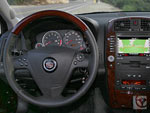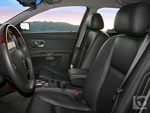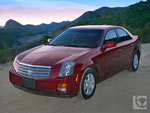 If you're not old enough to remember Woodstock, you probably don't recall a point in your life when Cadillac called itself the "standard of the world." Honestly though, there was a time when owning a 20-foot-long chrome-plated land mass told the world you'd made it, a time when being called the "Cadillac" of anything was a compliment of the highest order. Over the years, however, the world grew and its automotive standards grew with it. Even before the first Bush took office, BMW and Mercedes had long helped us realize that the world had more to offer.
If you're not old enough to remember Woodstock, you probably don't recall a point in your life when Cadillac called itself the "standard of the world." Honestly though, there was a time when owning a 20-foot-long chrome-plated land mass told the world you'd made it, a time when being called the "Cadillac" of anything was a compliment of the highest order. Over the years, however, the world grew and its automotive standards grew with it. Even before the first Bush took office, BMW and Mercedes had long helped us realize that the world had more to offer.It may have taken a few decades, but Cadillac finally took the "adapt or die" adage more seriously and did something about it. Its first move was this CTS, an early 2003 model whose high-output engine, rear-wheel-drive, slim measurements, and available manual transmission represented strong opposites of every idea that went into past Cadillacs. The name allegedly stands for Catera Touring Sedan, but don't take that literally: Cadillac had the confidence to do this one solo instead of asking for another round of sloppy seconds from German subsidiary Opel, who designed the Catera. And you know what? Our guys topped it.
Consider this CTS proof that traditional Cadillac dogma has crumbled.
Road Test

The first batch of cars was only about 90% finalized. Even by its second birthday, the CTS got a softened suspension and the new round of long-ago-planned engines had been fully phased in.
Before or after the changes, surely the CTS drives greater than anything you might call a predecessor. First, let's get it out of the way that Cadillac - like Mercedes, Lexus, Lincoln, and everyone else - missed the BMW target. The slightly numb, light wheel (early cars supposedly had high-effort steering) keeps the CTS an arm's length away from that magical man-machine connection. That said, focus shifts to what Cadillac did right, and the CTS does feel like a real luxury/sport sedan with fairly responsive steering, a good front-to-rear balance, and honest feedback through the hands and feet. The very gradual response of the drive-by-wire throttle might be off-putting to some, but there's no "slop" here or in the other main controls. (Our car didn't have the optional SpeedPro speed-sensitive steering.)
Likewise, if the CTS responds a little slowly to the wheel at creep-and-crawl speeds (the steering wheel has 3.4 turns of play), it feels right at all others. The tight turning radius makes it feel smaller than it is, and you can place this car right where you want on the road with no hint of old-time Cadillac ponderousness. Our test car was fitted with average-sounding 16-inch wheels (17s and 18s are optional), but they grip better than their specs promise. They also keep it easy to use power to kick out the tail, which in the CTS breaks away gradually. GM is best advised to remember all this as evidence that creating a new-from-the-ground up platform can pay off.
Likewise, the new engines were worth the wait. The CTS now has both 300 fewer pounds to pull than the Catera and an extra 55 horses to pull them, letting the new car dust the old by about two seconds in 0-to-60 (mid-6s vs. mid-8s). Our car had the new-in-2004 3.6-liter V6, GM's global all-aluminum piece with two cams, variable timing on all 24 of its valves, a dual-stage intake manifold, and all that other good stuff. Its 255 horsepower falls short of 3.5-liter engines from Mercedes, Infiniti, and Lexus (268, 280, 306) and its exhaust note is a little too anonymous, but it still gets the CTS around with haste. The 210-horsepower 2.8-liter V6, now the only other engine, shares all aforementioned design cues, and together they give Cadillac the only two engines in this class that don't ask for premium fuel (though the 3.6 prefers mid-grade).
The rare news of a stickshift in the Cadillac empire (it's a 6-speeder made by Aisin) will cause a few smiles, but let's focus on the 5-speeder HydraMatic that will serve the masses. For 2006 it gets that much-demanded manual-shift feature (Driver Shift Control) so drivers can tap north (to upshift) or south (to downshift) on the lever to row their own gears. Unfortunately, GM modeled its system after Toyota's, meaning the gear you choose merely becomes the highest gear to which it will shift on its own schedule. Blah, what was the point? I just sampled a perfectly programmed manumatic on a Pontiac G6, one of GM's supposedly lesser cars. Coordination, guys!
Well, no need to scrutinize a trivial feature too deeply. What matters is that the tranny has the right number of gears and shifts at the right times (if a little often). It seems partial to holding lower gears on downhill inclines to provide engine braking, but otherwise all was normal.
The CTS also covers the "TS" part pretty well, treating all riders to a fairly quiet experience and isolating them from what lies beneath. The worst bumps cause too much deflection and jounce in the suspension, but the double wishbones and multilinks treat you well the rest of the time.
Customers trading in their 20th century Cadillacs won't feel an ounce of familiarity, but can expect a ton more satisfaction.
Inside & Out

Feel free to call the CTS's lines anything you want. Any descriptor would be fair aside from "generic." The CTS is nothing if not different.
And different is fine, right up until it takes priority over taste. The CTS's interior looks like the result of ten different artists submitting ten conflicting ideas, all of which got the manager's stamp of approval. You have a mixed leather and wood steering wheel, odd curves and creases throughout, and a mix of mangled circles, rectangles, hemispheres, and other assorted polygons. Today's magic word is "juxtapose."
Another is "chaos," for the pieces coexist in disharmony. For one thing, it looks like a bodybuilder was hired to rip the center stack out of its roots and tilt it towards the driver. The acres of black get a little dour, and both the wood and the lettering on all the buttons look dorky. More pressing are the ergonomic flaws, such as the slightly annoying seat-mounted belts, the child-unsafe window switches, GM's nonsensical cruise and climate controls, and an obtusely inconvenient DVD navigation system that has buttons too many and one mouse too few. (It now features XM Nav Traffic to steer you clear of slow-moving roads for $12.99 a month.) Why must the clock, radio, and trip computer functions take part-time shifts in the main screen while the main odometer (who cares?) gets its own spot beside the major instruments? The rotary volume dial on the steering wheel seems like a good idea until you discover how easy it is to crank by accident. The map lights throw off narrow, weak beams of light. And if you're looking for the traction control switch, it's over there in the glovebox. Of course.
Let's finish this: few surfaces are pleasing to the touch, the plastic trim surrounding the flimsy-feeling door handle wiggles every time you use it, and the shift knob is falling off right now in our 3,000-miles-old test car. Something is amiss at the General when the $15,000 Chevrolet Cobalt can claim more logic in the controls, more taste in the design, and just as much class. Oh, and that economy car's optional Pioneer stereo beats the pants off of the Cadillac's bland Bose.
But for all the frustrations to the eyes, ears, and mind, the body will never know. The CTS's chairs fit as well as any, with flexible power adjustments and good shaping. They're slightly wide and soft, but not mushy. They're stitched with good leather, and there are good cupholders and consoles besides. (Skimpy glovebox, though.) And it does have adjustable lumbar support now, unlike at the outset. Now all it needs is a steering wheel that telescopes (imperative at this price), has smaller-degree steps in its tilt function, and isn't so giant and impersonal.
The more pleasant surprise is in the second row. Seat comfort isn't exceptional or anything, but it is nice and firm, the driveline bulge is fairly modest, and as one of the few genuine mid-size cars in its class, Cadillac clobbers the current crop of compact competitors. The somewhat high beltline reduces the feeling of spaciousness for everyone, though.
The well-designed trunk finishes the job with its above-average room.
Other Thoughts

So the most affordable Cadillac in 2006 runs for $31,235. The 3.6-liter V6 runs $2,645 extra - very reasonable considering it replaces the base model's embarrassing vinyl seats with leather (which alone goes for $1,300). After adding the $1,200 automatic transmission, most people will be looking at a starting price of $32,435 or $35,080.
With either engine, the CTS has a Luxury Package (two-driver memory, burl accents, electrochromic auto-dimming mirror, heated seats with power lumbar, power passenger's seat, garage door opener, alarm, and brighter wheels) and a Sport Package (sport suspension, speed-sensitive variable-assist steering, StabiliTrak stability control, limited-slip differential, performance brakes, 17-inch wheels, and HID lights). The 3.6-liter V6 has two more sport packages that build upon the main one: the 18-inch Wheel Performance Package (adds load-leveling rear suspension, tire pressure monitor, P225/50R18 tires) and 18-inch Wheel Sport Appearance Package (all that plus sport rocker moldings, chrome exhaust tips, sport grille, and spoiler). A moonroof's another $1,200.
The 35-grand CTS with the 3.6-liter has plenty of company. With peers like the Lexus IS350, BMW 330i, Mercedes C350 at $36,030, $38,570, and $38,925, Cadillac seems to be offering a fair deal.
However, by naming such names as the competition, Cadillac isn't giving itself enough credit. Let's not forget that this is a mid-size car. Maybe barely, but it is: 190.1 inches long by 70.6 wide by 56.7 tall with a wheelbase of 113.4, amounting to 110.8 cubic feet of interior volume. Let us also not forget that all those other companies charge about $10,000 extra for their mid-size offerings. The CTS may have its flaws, but since they're mostly in the details, how can you argue with a five-digit discount?
Only one car shares the CTS's core advantage: the Infiniti G35. They're spitting images of each other: early 2003 mid-size sports sedans that spearheaded the revival of their respective companies. Honestly, the G35 has a slight edge in design, comfort, and is an even better value. But if for some reason you can't stand Infiniti, this Cadillac is definitely worth a cross-shopping against all those arrogantly-priced peers.
Mention the CTS-V and it gets even better. At $52,495, Cadillac's 400-horsepower warrior (which now uses the new Corvette's LS2 V8) undercuts Mercedes' E55 and BMW's M5 by more than 30 grand. Ok, so it also has a deficit of 69 or 100 horsepower, but it still stomps the $64K 400-horsepower Jaguar S-Type R in every way. (The CTS's manual-only transmission places it closer to the M5 than the automatic Merc or Jag.) [source : automotive.com]
Post a Comment